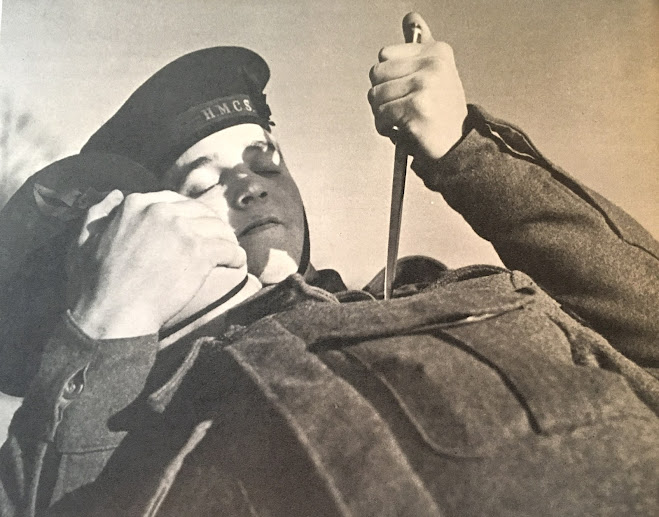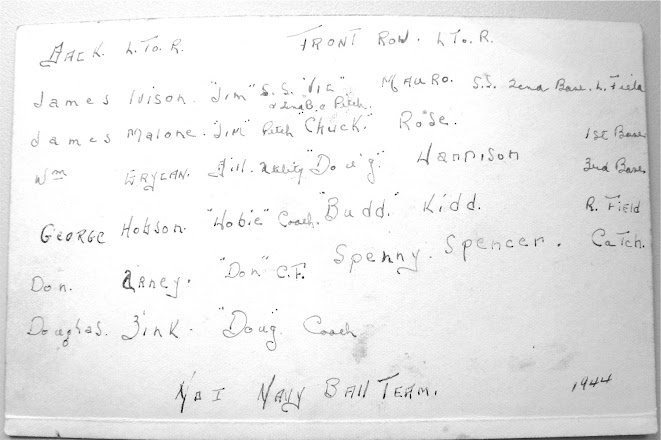Canadians in Combined Ops Share Memories of Comox Spit
Key Excerpts from St. Nazaire to Singapore, Volume 1
Behind the LCM is the town of Comox, 1943 - 1945. The wooden craft
was likely launched from 'the spit', the nearby navy base
Beyond the small cove (at low tide) is Comox, 2014. The photographer was
standing near the entrance of HMCS Quadra, formerly Givenchy III. GH
The watery course that scores, perhaps hundreds of Canadian sailors followed during WWII ended up on a small navy base - situated on a short spit, about 1 - 2 kilometres in length - near Comox, Vancouver Island. Though the majority of Canadians may have started serving the RCN or RCNVR by enlisting at one of several well-known Navy establishments (e.g., at the HMCS Toronto, Ottawa, Halifax, Vancouver, London, or Hamilton division, etc.), a relative handful celebrated VE-Day and perhaps the end of the war at the little-known base at Comox, HMCS Givenchy III.
There are several informative short stories, news columns or memoirs that relate to the roles, responsibilities and adventures of the members of the Canadian Navy - my father being but one - who served on 'the spit' during the second world war. Some of the details are shared below.
First, an excerpt from a book purchased at the Canadian War Museum:
Early in 1942 the fear of Japanese landings on the sparsely-populated west coast of Canada led to the suggestion that Fisherman's reserve personnel should be trained in commando tactics and man ex-Japanese fishing vessels. At the same time the Joint Services Committee on the west coast was considering a more elaborate scheme involving combined army-navy Operations and the use of assault landing craft.
Early in 1942 the fear of Japanese landings on the sparsely-populated west coast of Canada led to the suggestion that Fisherman's reserve personnel should be trained in commando tactics and man ex-Japanese fishing vessels. At the same time the Joint Services Committee on the west coast was considering a more elaborate scheme involving combined army-navy Operations and the use of assault landing craft.
The scheme as finally worked out involved the use of a hundred wooden landing craft provided by the army, manned by the navy, and maintained by both services... operational bases were to be established at Prince Rupert... and at Hardy Bay, Alberni, Nanaimo, and Comox, on Vancouver Island. Basic naval training started at William Head near Esquimalt in July 1942. Combined-Operations training with the army was undertaken at their establishment at Courtenay on the eastern side of Vancouver Island, and began in October...
As found in Naval Service of Canada: Its Official History, page 210
The excerpt continues:
Early in 1943 the army decided that bases for combined Operations on the west coast were no longer necessary as a defence measure. Meanwhile, however, the training in Canada of combined-Operations personnel for service in the European theatre of war had been given careful consideration, and as a result of these developments the entire policy was revised.
All operational bases were abandoned, and the entire combined-Operations activities were concentrated at Courtenay. Naval training later moved to the nearby naval camp at Comox Spit, formerly operated by HMCS "Naden" for musketry and seamanship training. This establishment became known as "Givenchy III." In February 1944 there were 51 landing craft on the west coast of which all but 8 were based on Comox.
More history re Canadians in Combined Ops at Comox and Courtenay, shared by Bob Berger:
For more information about the Canadian link to Combined Operations, please link to Comox, BC: Some History - HMCS Givenchy III, 1940s (1)
Unattributed Photos GH
As found in Naval Service of Canada: Its Official History (Volume II - Activities on Shore During the Second World War) by G. N. Tucker, pages 231 - 232
The 'official history' as stated above sounds a little bit more official when details are confirmed by other writers, especially if there are among them a few writers who served at Navy bases on Vancouver Island, especially HMCS Givenchy III. And in a two-volume set of books filled with Navy veterans' stories (St. Nazaire to Singapore - The Canadian Amphibious War 1941 - 1945, assembled by David (RCNVR) and Catherine Lewis and Len Birkenes (RCNVR)) we find such writers/details/stories.
The 'official history' as stated above sounds a little bit more official when details are confirmed by other writers, especially if there are among them a few writers who served at Navy bases on Vancouver Island, especially HMCS Givenchy III. And in a two-volume set of books filled with Navy veterans' stories (St. Nazaire to Singapore - The Canadian Amphibious War 1941 - 1945, assembled by David (RCNVR) and Catherine Lewis and Len Birkenes (RCNVR)) we find such writers/details/stories.
The set of books can be read online and I encourage readers to peruse the many stories at their leisure at a University of Calgary site - link to St. Nazaire to Singapore, Volume 1
I share below photo images of relevant excerpts re Comox history found on pages 102 - 106 along with further explanatory details where possible:
There may have been some obvious similarities and differences between the earlier "home Combined Operations Training" and later "Mountbatten methods". I would say that I am chiefly familiar with the training undertaken by the Canadians who volunteered for the Combined Operations (British) organization beginning with the first drafts of sailors to go overseas from Canada in January, 1942.
Many if not all of the members of the first draft (including my father), and many of those that followed soon thereafter (including the "officers and cox'ns" mentioned above) returned to Canada in early December 1943 after almost two full years overseas. Some of those sailors were placed or volunteered to serve at the spit in Comox beginning in January 1944.
And that being said, some of those Canadians took part in four operations (not recalled as "Canadian Combined Operations"): Operation Rutter (re Dieppe - cancelled), Operation Jubilee (Dieppe, April 19, 1942), Operation Torch (North Africa, Nov. 8, 1942), Operation Husky (Sicily, July 10, 1943), and Operation Baytown (Italy, toe of the boot, Sept. 3, 1943). "Three Canadian Combined Operations" may have been mentioned because, though Canadian sailors manned landing crafts at Dieppe, there may not have been designated Canadian flotillas of landing crafts as in later operations.
The first excerpt continues:
Bob Berger, mentioned in the last excerpt, penned the following informative entry. Bob started out in Canada and became familiar with Commando training (possibly) beginning as early as August 1942, about the time of the Dieppe raid.
It is perhaps interesting to note the similarities in the training sailors undertook whether in Canada or in overseas' camps. Those that had gone overseas in January 1942 also trained like commandos while learning how to handle landing crafts at Irvine and Inveraray, Scotland (not knowing that their first raid was but a few months away. Mr. Berger notes how his training changed once his "role changed" and he moved to Courtenay, then nearby Comox on Vancouver Island. His comments about new, Canadian-made Landing Crafts Mechanised (Wooden) or LCM (W)s are unique and confirm reports in a text mentioned here earlier in the post:
Note the line above: "... one of the boys who had been over (i.e., overseas) in the 80th (flotilla of landing crafts) without a scratch got it in the arm that was on the gunwale ready to lower the ramp..."
Navy hammock belonged to W. N. Katana, Leading Stoker, of 80th Canadian
Flotilla; now at Navy Museum, Esquimalt B.C. Viewed by appointment only.
My father D. Harrison is listed in right hand column. He and Jim Malone (also
listed on hammock) appear in Navy baseball team photo that is shared below
Berger mentions camping in "a tent city in the city park" once he arrived in Courtenay. Below is a tent city (same one?) near Courtenay, 1942 - 44, approx:
Photo Credit - The Crows Nest, March 1958 issue
Photographs of landing crafts produced in Vancouver appear in an ad below:
The advertisement appears in Canada's War at Sea, by Stephen Leacock
and Leslie Roberts. Foreword by PM William Lyon Mackenzie King
Published in 1944. From collection of Gordon Douglas Harrison
Bob Berger also comments on Commando training and there is much still to learn in this department. Below is a photo with caption related to Canadian sailors:
Photo Credit - H.M.C.S.: One Photographer's Impression of the RCN
by Gilbert A. Milne, page 87
Bob Berger's excerpt continues:
Some of the sailors and officers have been highlighted in several places on the site. (Click here for more details about Commander Windeyer).
Don Westbrook was from Hamilton and he trained in the summer of 1941 at Hamilton Division 1 (later HMCS Star) at the same time as other new recruits who ended up eventually in the 80th and 81st flotillas (e.g., Chuck Rose, Joe Watson, Art Warrick, Doug Harrison, Art Bradfield and many more. Ed Corbett's name appears on the hammock and his set of St. Nazaire to Singapore - The Canadian Amphibious War can be found at the Courtenay Museum and Archive. Related photos below:
Landing craft like ducks in a row at Comox. Heading to Tree Island?
Photo - Land of Plenty - History of Comox District
Members of (likely) 81st flotilla aboard HMS Keren, in the Atlantic, on the
way around Africa to get to Sicily, 1943. See Westbrook and Rimmer.
his place" likely refers to married quarters at HMCS Givenchy III
Photos from the collection of Doug Harrison
LCM(W)s parked in Courtenay Slough, beside Dyke Road to Comox. Page 104
Two memorial plaques related to Combined Operations and landing craft can be found in Courtenay, in Lewis Park (still home to lots of baseball) and near the slough - still home to many parked boats:
This last entry comes from page 105, St. Nazaire to Singapore Volume 1:
After "Shadow" Walsh's report, Bob Berger contributes two final photos, one of which I have in original form (e.g., a clean photo with names on the back:
From collection of Doug Harrison, RCNVR/Combined Operations 1941 - 45
Berger's final photo relates to VE Day at Comox and there may be 2 - 3 ball players (above team) in the group shot, e.g., Jim Ivison, Don Arney and Jim Malone:
A modern-day pier stands on 'the spit' providing great views of surroundings
For this view of HMCS Quadra I was near the top of a sturdy stairway
Unattributed Photos GH






























No comments:
Post a Comment